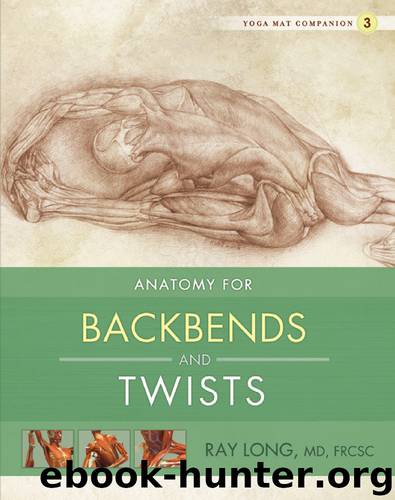Anatomy for Backbends and Twists by Ray Long

Author:Ray Long
Language: eng
Format: epub
Tags: Yoga, Anatomy, Biomechanics, Physiology, Poses, Asana, Vinyasa, cues, stretching, backbends, twists
Publisher: BookBaby
Published: 0101-01-01T00:00:00+00:00
STEP 1 Several muscle groups are active in the standing leg. The hip abductors (the tensor fascia lata and gluteus medius) automatically engage when we stand on one leg. This tethers and balances the pelvis by pulling on the origins of these muscles at the iliac crest. If the adductors are weak or paralyzed, the pelvis sags over to the side of the leg that is in the air. This is known in medicine as the “Trendelenburg sign.” Visualize these muscles at work to better stabilize the pose from the pelvic core.
The quadriceps contract to straighten the knee and the tensor fascia lata synergizes this action, in addition to stabilizing the knee joint from the outside. Press the ball of the foot into the mat to engage the peroneus longus and brevis. Then spread the weight across the sole by activating the tibialis posterior (this muscle everts the ankle). Use the toe flexors to refine your balance. Remember that primary stability originates from the pelvis. Refined stability is an interplay among the various muscles of the foot and ankle.
Download
This site does not store any files on its server. We only index and link to content provided by other sites. Please contact the content providers to delete copyright contents if any and email us, we'll remove relevant links or contents immediately.
Tools of Titans by Timothy Ferriss(7818)
Bodyweight Strength Training by Jay Cardiello(7679)
Born to Run: by Christopher McDougall(6897)
Inner Engineering: A Yogi's Guide to Joy by Sadhguru(6444)
Asking the Right Questions: A Guide to Critical Thinking by M. Neil Browne & Stuart M. Keeley(5358)
The Fat Loss Plan by Joe Wicks(4628)
Bodyweight Strength Training Anatomy by Bret Contreras(4478)
Yoga Anatomy by Kaminoff Leslie(4107)
Science and Development of Muscle Hypertrophy by Brad Schoenfeld(3972)
Dynamic Alignment Through Imagery by Eric Franklin(3923)
ACSM's Complete Guide to Fitness & Health by ACSM(3826)
The Four-Pack Revolution by Chael Sonnen & Ryan Parsons(3797)
Exercise Technique Manual for Resistance Training by National Strength & Conditioning Association(3789)
Bodyweight Strength Training: 12 Weeks to Build Muscle and Burn Fat by Jay Cardiello(3784)
Yoga Anatomy by Leslie Kaminoff & Amy Matthews(3743)
The Ultimate Bodybuilding Cookbook by Kendall Lou Schmidt(3710)
Yoga Therapy by Mark Stephens(3577)
Nutrition for Sport, Exercise, and Health by Spano Marie & Kruskall Laura & Thomas D. Travis(3559)
Nutrition for Sport, Exercise, and Health by Marie Spano & Laura Kruskall & D. Travis Thomas(3552)
